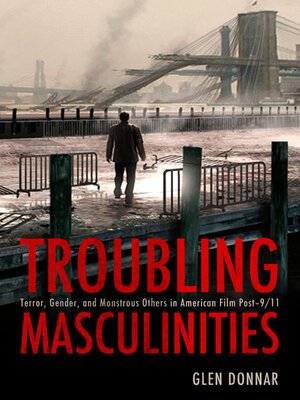Troubling Masculinities
ebook ∣ Terror, Gender, and Monstrous Others in American Film Post-9/11
By Glen Donnar

Sign up to save your library
With an OverDrive account, you can save your favorite libraries for at-a-glance information about availability. Find out more about OverDrive accounts.
Find this title in Libby, the library reading app by OverDrive.



Search for a digital library with this title
Title found at these libraries:
| Library Name | Distance |
|---|---|
| Loading... |
Troubling Masculinities: Terror, Gender, and Monstrous Others in American Film Post-9/11 is the first multigenre study of representations of masculinity following the emergence of violent terror as a plot element in American cinema after September 11, 2001. Across a broad range of subgenres—including disaster melodrama, monster movies, postapocalyptic science fiction, discovered footage and home invasion horror, action-thrillers, and frontier westerns—author Glen Donnar examines the impact of "terror-Others," from Arab terrorists to giant monsters, especially in relation to cinematic representations in earlier periods of national turmoil.
Donnar demonstrates that the reassertion of masculinity and American national identity in post-9/11 cinema repeatedly unravels across genres. Taking up critical arguments about Hollywood's attempts to resolve male crisis through Orientalizing figures of terror, he shows how this failure reflects an inability to effectively extinguish the threat or frightening difference of terror. The heroes in these movies are unable to heal themselves or restore order, often becoming as destructive as the threats they are supposed to be fighting.
Donnar concludes that interrelated anxieties about masculinity and nationhood continue to affect contemporary American cinema and politics. By showing how persistent these cultural fears are, the volume offers an important counternarrative to this supposedly unprecedented moment in American history.
Donnar demonstrates that the reassertion of masculinity and American national identity in post-9/11 cinema repeatedly unravels across genres. Taking up critical arguments about Hollywood's attempts to resolve male crisis through Orientalizing figures of terror, he shows how this failure reflects an inability to effectively extinguish the threat or frightening difference of terror. The heroes in these movies are unable to heal themselves or restore order, often becoming as destructive as the threats they are supposed to be fighting.
Donnar concludes that interrelated anxieties about masculinity and nationhood continue to affect contemporary American cinema and politics. By showing how persistent these cultural fears are, the volume offers an important counternarrative to this supposedly unprecedented moment in American history.







